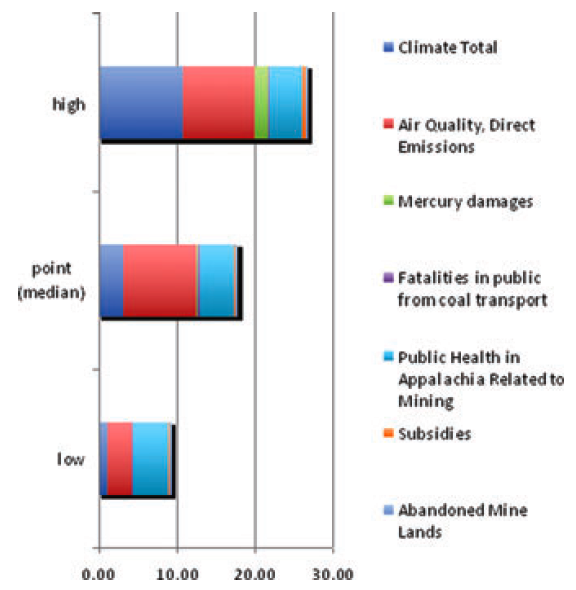
Due to its abundance and low market price, coal combustion is the largest source of energy production in the world, accounting for 40% of all electricity worldwide. In the USA it accounts for 45% of electricity generation, and approximately 75% in Australia.
Unfortunately, coal combustion is a major contributor to global greenhouse gas emissions as well, accounting for 30% of total anthropogenic carbon dioxide (CO2) emissions worldwide, and 72% of CO2 emissions from global power generation. In addition, non-power generation uses increase its contribution to global human CO2 emissions to a whopping 41% (as of 2005).
A major problem with coal is that its full costs are not reflected in its market price, and thus while we may seemingly purchase and burn coal cheaply, in reality we are paying a much higher cost in the long run, if we look at the big picture. Economists refer to the impacts on human and environmental health which are not reflected in the price of coal as "externalities". Those who benefit from the seemingly cheap electricity don't pay for these externalities directly, but the public eventually has to pay in the form of medical bills, environmental cleanups, etc.
In a new report published in the Annals of the New York Academy of Sciences, Epstein et al. (2011) do a full cost accounting for the life cycle of coal, taking these externalities into account. Among the factors included in this analysis were:
Note that most of these external factors do not apply to most non-fossil fuel energy sources. The majority of the externality costs come from reduction in air quality, contribution to climate change, and impacts to public health. Epstein et al. find that the total cost of these externalities ranges from approximately 9 to 27 cents per kilowatt-hour (kWh) of electricity generated, with a median of approximately 18 cents per kWh. The authors note that this is a conservative estimate, because they have not accounted for every associated impact.

Figure 1: Coal externalized cost (cents per kWh) from Epstein et al. (2011)
The US Energy Information Administration provides a comparison of levelized costs for different power generation sources. Levelized cost represents the present value of the total cost of building and operating a generating plant over a period of time, and reflects overnight capital cost, fuel cost, operation and maintenance costs, financing costs, and an assumed utilization rate for each plant type. To convert from dollars per megawatt-hour to cents per kWh, move the decimal point in the table below one spot to the left (for example, conventional coal is 9.48 cents per kWh on average).

As you can see, the externalities are sufficient to triple the cost of coal power, if they were reflected in its price. If we include the coal externalities, it increases the levalized costs to approximately 28 cents per kWh, which is more than hydroelectric, wind (onshore and offshore), geothermal, biomass, nuclear, natural gas, solar photovoltaic, and on par with solar thermal (whose costs are falling rapidly). Suddenly coal doesn't look like such a good deal.
Epstein et al. conclude by offering a number of recommendations:
Ultimately it's a significant problem that we rely so heavily on coal to meet our energy needs due to its artificially low market price. It's like eating junk food for every meal. It's cheap, it tastes good, but it's not healthy and eventually you'll pay the price through poor health, high medical bills, and a shortened lifespan.
We may not pay the costs of climate change, lost biodiversity, air and water pollution, adverse health effects, etc. up front, but we do have to pay them eventually. We need to follow the recommendations of Epstein et al., transform our energy infrastructure, and move away from our dependence on coal and other fossil fuels.
Coincidentally, the US EPA has just proposed national standards for mercury, arsenic and other toxic air pollution from power plants. These standards will "require many power plants to install widely available, proven pollution control technologies to cut harmful emissions of mercury, arsenic, chromium, nickel and acid gases, while preventing as many as 17,000 premature deaths and 11,000 heart attacks a year." This is a good step in ensuring that some of the externalities discussed in this article are internalized and taken into account. Coal power plants were exempted from meeting the requirements of the Clean Air Act until 2000, and these new EPA standards will finally ensure that air pollution from coal power plants is regulated, rather than being freely released into the atmosphere.
Posted by dana1981 on Friday, 18 March, 2011
 |
The Skeptical Science website by Skeptical Science is licensed under a Creative Commons Attribution 3.0 Unported License. |